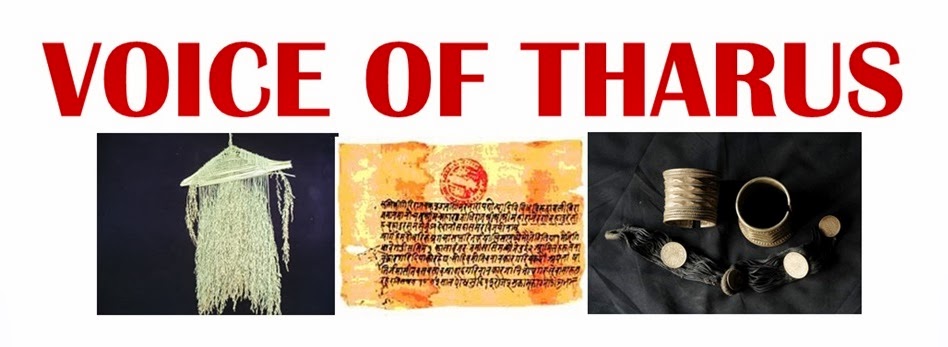 |
| Kakahi - the comb |
 |
| Kauwa tholi - the crow's beak |
 |
| Maur - the bridegroom's turban |
 |
| Patiya - the mat |
The children await the harvest with much eagerness. After school hours or taking turns to herd the cattle and goats they glean rice from fields. Scouring the fields they search the rice stalks missed by the reapers. The collected rice is bartered with the petty sellers offering local delicacies (jilebi, kachari, and sweets). The rice is often sold in shops and the sum is saved to spend in the melas (village fetes) and haats (make-shift markets).
Meanwhile the farmers prepare jhuttis – artistic form of rice stalk sheaf weaving. Especially, the Tharus prepare jhuttis for each variety of rice they harvest. The jhuttis are hung high on the meh (the bamboo pole to which the oxen are tethered while threshing rice).
Art inspired by nature, for love of nature
Jhuttis are of different shapes and sizes. They are inspired by the nature and the things around like, kauwa tholi – the crow’s beak, patiya – the mat, kakahi – the comb, jhunjhuna – the baby’s toy, bena – the fan, bakhari – the granary, maur – the turban a bridegroom wears in Terai.
The belief is that – after the rice is harvested, there remains nothing for the birds to peck at. Hence, the tradition started, with keeping a jhutti of each species of rice harvested. The jhuttis thus, hung provided food for the birds. It shows the love for nature and conservation among the Tharus.
“Our ancestors loved and worshipped the nature,” says Chandra Kishore Kalyan, President of Tharu Welfare Society, Siraha. “They weaved jhuttis so that the birds didn’t die of hunger after harvest.”
Reviving the age-old culture
With the introduction of machines, the farmers are leaving behind the tradition. Even the traditional rice threshing is becoming obsolete. Now the farmers resort to using machines for the purpose. The joy and celebration of rice threshing using oxen, hanging jhuttis on the bamboo pole is becoming rarer.
To revive the age-old tradition, Barchhawar Community Development Forum organized a ‘Jhutti Competition’ last year. The competition attracted interest from local people with one hundred and fifty entries and brought out the Tharu culture in the national media. The organizers opine that the competition has not only informed the young generation about their culture but also reawakened their love towards the dying tradition. The forum will give continuity to it in the days to come.
Traditional healing
The Tharus believe that the jhutti rice is a cure for nausea. Nathar Tharu of Sishwani village, Siraha in east Nepal has a collection of 20-25 years old rice. He provides the rice for free to the people suffering from nausea.
Month of creativity
The month of November is special to Tharu women. It’s the time to show their creativity. They weave the jhuttis in their leisure time and the young girls learn the trick while herding the goats and cattle. Playing with the rice sheaf they come up with the beautiful shapes and size.

Thanks for ur publication.....
ReplyDeleteIts Alwazzzzzzzz interesting to go through ur Blog..... Dai.... u simply hav gr8 collection.....
ReplyDeleteThank you so much. Please keep tracking the posts.
ReplyDeletenice bog
ReplyDeleteThanks Aditya.
DeleteIn rupandehi and nawalparshi we call fetbeniya
ReplyDelete